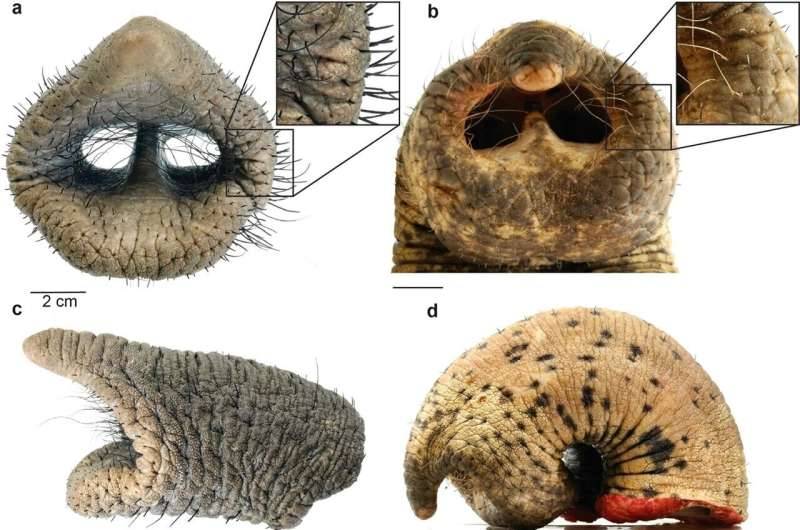June 9, 2023 report
This article has been reviewed according to Science X's editorial process and policies. Editors have highlighted the following attributes while ensuring the content's credibility:
fact-checked
peer-reviewed publication
trusted source
proofread
Why elephants have whiskers on their trunks

A team of zoologists from the Bernstein Center for Computational Neuroscience Berlin, Humboldt-Universität zu Berlin, the Leibniz Institute for Zoo and Wildlife Research and Berlin Zoological Garden has discovered the purpose of whiskers on elephant trunks. In their project, reported in the journal Communications Biology, the group studied elephant trunks and their whiskers in two ways.
The elephant trunk is, by all accounts, one of the more unique appendages among the animals of the world. It is both sensitive and strong, with approximately 150,000 muscle units. It is also quite versatile; besides using them to breathe, elephants use them to pick things up, to suck up water and to spray that water either into their mouth for drinking or to spray it over their backs to provide relief from flies.
Elephants have even been observed using their trunks as a snorkel, allowing them to walk on the bottom of a creek as they cross. Less well known is the purpose of the whiskers along the length of the trunk. In this new effort, the research team sought to find their purpose.
The first part of the study involved making close-up video recordings of elephant trunks in action—several elephant volunteers were induced to poke their trunk through a hole in a box to retrieve a treat, such as a carrot or an apple. The researchers then watched closely to see what role, if any, the whiskers on the trunk played in grabbing the treat. They discovered that the whiskers did not work like those in other mammals such as rats—they did not move, twitch or react to the environment in any noticeable way.
In the second part of their work, the team dissected trunks from elephants that had died. They found that the whiskers were thicker than those of other mammals, and were cylindrical. They also did not have follicular nerves that would allow them to be used for sensory purposes.
They concluded that the purpose of the whiskers is to help the elephant gauge how much pressure to use when squeezing an object—an important attribute, considering the variety of objects that elephants hoist.
More information: Nora Deiringer et al, The functional anatomy of elephant trunk whiskers, Communications Biology (2023). DOI: 10.1038/s42003-023-04945-5
Journal information: Communications Biology
© 2023 Science X Network


















